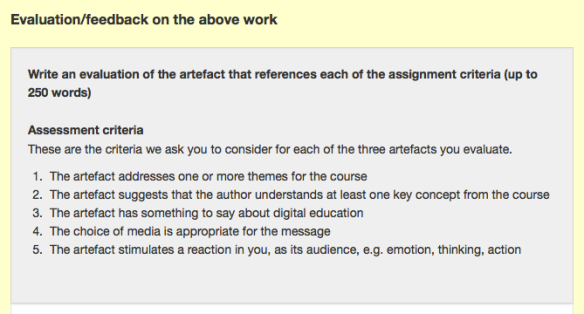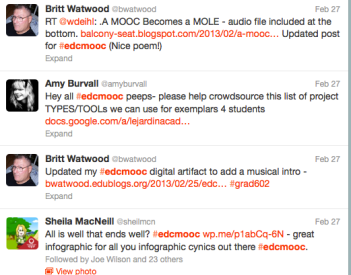In this post I share my peer grading experience as a student in the e-learning and digital cultures course [edcmooc] offered through Coursera. I’ll provide readers a window into the student experience —how it works, guidelines provided by the instructors and assignment criteria. I’ll also share the assignment I submitted for this course and share the results—grades and comments provided by four students that evaluated my digital artefact.
 My last post delved into peer grading, the pedagogy and the learning theories behind the process of peer grading. I thought readers may find it useful to view the experience from the inside, viewing the process as a student would.
My last post delved into peer grading, the pedagogy and the learning theories behind the process of peer grading. I thought readers may find it useful to view the experience from the inside, viewing the process as a student would.
Description of Assignment: A Digital Artefact
Within the five-week course, topics included, a) what it means to be human in a digital world, b) utopian and dystopian views of our world past, present and future, and c) how learning is influenced by technology in today’s digital culture. There was one assignment for the course, an artefact [artifact spelled the British way is with an ‘e’], a digital presentation representative of two or more concepts from the course, as described below:

Description of assignment for #edcmooc from the course web site. Below this introduction on the page within the course website, were further detailed directions and guidelines, including how long the assignment should be, suggestions for platforms to use, i.e. Voicethread, Pixton, Prezi, etc. possible topics, and assignment criteria which in turn was used for grading purposes.
I learned far more than I expected from the process of completing the assignment, and from the peer grading exercise itself. It was engaging, quite enjoyable, and if we use the activity on the social networks as any indication, numerous students appeared to feel the same as I did. Discussions on Twitter @#edcmooc were prolific and are still going strong.
Student Enthusiasm for Peer Grading
Students appeared highly engaged, excited about the results of the assessments, theirs and others during the three-day evaluation period. Students shared on the courses’ Facebook page, they Tweeted, they discussed, and posted questions seeking advice about grading. Peer grading seemed to be taken quite seriously by active students.
Assignment Criteria
Often neglected in online courses are clear and specific descriptions provided about class assignments, the why, the how and the purpose. In my experience working with faculty in designing online courses, writing the narrative to cover these points requires time and attention to detail, but is well worth the time it takes, and instructors in #edcmooc followed these principles to a tee. One example is the assignment criteria:
“These are the elements peer markers will be asked to consider as they engage with your artefact. You should make sure you know how your work will be judged by reading these criteria carefully before you begin.
- The artefact addresses one or more themes for the course
- The artefact suggests that the author understands at least one key concept from the course
- The artefact has something to say about digital education
- The choice of media is appropriate for the message
- The artefact stimulates a reaction in you, as its audience, e.g. emotion, thinking, action” [Coursera, e-learning and digital cultures]
The Grading—How it Worked
The instructions provided on how to grade were thorough, and once I started the process of grading, the system guided me through following the assignment criteria closely. From the course website, with use of screen shots:
What you have to do
“When you have submitted your own artefact, the system will give you access to three other artefacts created by your peers, on which we ask you to provide feedback, and to offer your evaluation. This feedback will take the form of numbers and comments. It will involve the following steps for each”. Following this paragraph where further descriptions on how to make comments, (provide reasons), how to give and receive feedback, and encouraged further discussion and sharing on social media platforms after the close date of the assignment and included links for further reading on the peer review process and critical thinking.

Screen shot: The first step we had to do in grading was, upon reviewing the artefact, was to give feedback according the criteria for this assignment.
My Artefact and Peer Feedback
My artefact which I submitted for grading focused on the theme of ‘being human in a digital world’ and included the concepts discussed in the course—humanism, posthumanism and transhumanism specifically. I used the platform of Pinterest [which I joined some time ago, but didn’t use until this assignment]. I was pleasantly surprised at how effective this tool was; I was able include a fair bit of text to describe and summarize the concepts with image files, or embedded YouTube clips.
Peer Feedback
The quality of feedback I received from the student graders was overall very good. I was impressed with the comments, the insight and depth given the assignment criteria. Also of note what how peer #2 mentioned reviewing the board helped him or her to ‘conceptualize the concepts’. This is an example of how peer grading can enhance learning for students.
Conclusion
I wrote in a previous post, A Tale of Two MOOCs @ Coursera, how the e-Learning and digital cultures format was an excellent example of a connectivist learning environment; a student focused learning community where students learn through making connections within a network. The digital artefact assignment and peer grading method were excellent choices in keeping with the connectivist course—students not only made connections within social networks throughout the course, but the peer review process served as a means to further conceptualize learning, expand personal connections beyond the class network, and prompted students to share their work with peers after the formal grading process using their real identities. The value of peer grading in this course went far beyond the grade and feedback each student received on his or her assignment; it created opportunities for learning that traditional grading could never provide. It was a brilliant fit for this course.
Links to #edmooc discussions and Final assignment Sharing
- Facebook Group, #edcmooc
- e-Learning and Digital Cultures Student Review, Course Talk
- #ecdmooc Project Types, Google Doc
- edcmooc, Flickr







Reblogged this on The MOOCs Explorer and commented:
An insightful summation of the EDCMOOC – a course that I am currently following right now.
LikeLike
Thank you for your web-site post.
LikeLike
Pingback: Peer Grading: A Student Perspective in an Open and Online Course | Education Equipment | Educational News
Pingback: a final word? hardly | another space oddity
Thanks – that was really useful. Did the faculty also give a grade for the assignment and/or for the quality of the peer reviews? Were you or others able to rate your peers’ reviews of your work for usefulness? If not, do you think either of those would be a useful addition?
LikeLike
Hi Peter, Glad you found the post useful. Faculty were not involved at all in the process, in this case due to the sheer numbers of students, though I know they did read some of the projects which one or more of the instructors mentioned on Twitter. Though the instructors did provide a helpful description of guidelines for grading etc. on the course home page. They also provided links to several resources that supported the concept of peer grading.
What you point out is significant, as much of the research suggests that students’ grading is more accurate and effective with practice. In small settings, classes of 40 or under, this is manageable; the instructor has control of the class and is able to guide students, provide practice and instruction. However, in a class of thousands, this is not possible. Hope that helps!
LikeLike
Pingback: Peer Grading: A Student Perspective in an Open and Online Course | Halina's Blog
Reblogged this on Things I grab, motley collection .
LikeLike